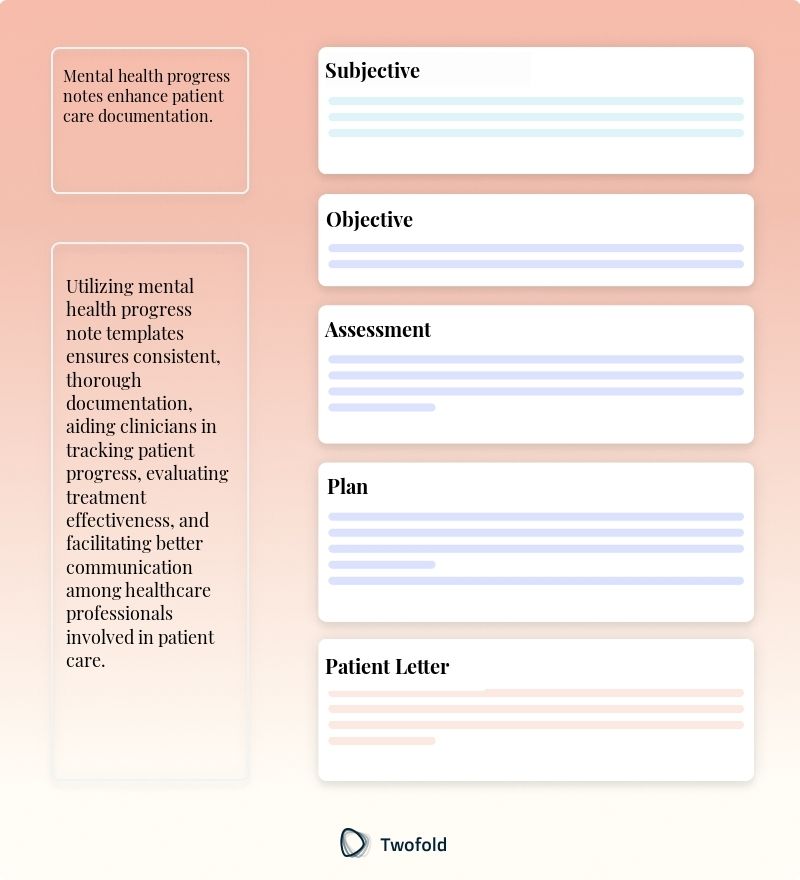
Mental Health Progress Note Template
Imagine you're in the middle of a busy day as a mental health professional and your last session just ran over time. You're feeling the pressure to quickly yet accurately document your client's progress without compromising on quality. Sounds familiar? Well, you're in the right place. In this post, we'll explore the ins and outs of the Mental Health Progress Note Template, offering insights and tips that could save you time without losing that crucial personal touch in your notes.
What Is a Mental Health Progress Note Template?
A Mental Health Progress Note Template serves as a structured method for documenting interactions between mental health professionals and their clients. It helps in maintaining consistency and clarity across clinical records, aiding in effective communication amongst healthcare providers.
These templates typically encompass sections that detail the client's status, the therapist's observations, and any changes in treatment plans. By standardizing documentation, they promote efficiency and comprehensive record‑keeping.
Key Components of a Mental Health Progress Note?
Below are the primary elements that make up a Mental Health Progress Note:
- Client Identification: Name, date of birth, and session date.
- Session Narrative: Key points and goals discussed during the session.
- Clinical Observations: Therapist's observations on mood, behavior, and engagement.
- Interventions: Techniques or therapies applied in the session.
- Progress Evaluation: Insight into client's progress toward therapeutic goals.
- Plan of Action: Future goals and strategies to be implemented.

How to Use a Mental Health Progress Note Template: Step-by-Step Process
Step 1: Gather Client Details
Begin by entering the client's identification details, ensuring you have the correct session date and personal information.
Step 2: Document the Session Narrative
Provide a detailed account of the session's activities, including the major topics discussed and therapeutic goals.
Step 3: Record Clinical Observations
Note any observations related to the client's demeanor, mood changes, and responsiveness during the session.
Step 4: List Interventions Used
Summarize the therapeutic techniques and interventions applied and how the client responded to them.
Step 5: Evaluate Client's Progress
Assess how well the client is progressing towards set goals and document any noticeable changes or lack thereof.
Step 6: Outline the Plan of Action
Conclude with a proposed plan for upcoming sessions, adjusting goals and strategies as necessary.
Benefits of a Mental Health Progress Note
Benefit | Description |
|---|---|
Consistency | Ensures uniformity in documentation, making records easier to follow and understand. |
Efficiency | Streamlines the documentation process, saving time without compromising on content richness. |
Comprehensiveness | Includes all necessary sections required for a complete clinical picture. |
Compliance | Helps adhere to legal and professional standards in record-keeping and data protection. |
Stakeholders in Mental Health Progress Note
Various professionals might interact with the Mental Health Progress Note, each bringing their expertise:
- Therapists: These professionals are at the core of documenting client progress, leveraging notes for therapy adjustments. For instance, a therapist might revise treatment approaches based on client's reactions recorded in past sessions.
- Psychiatrists: Used for tracking medication effects and making informed decisions on pharmacological treatments. An example would be adjusting dosages based on progress noted in the documentation.
- Insurance Providers: These stakeholders require comprehensive notes for validation of claims and coverage. Documentation accuracy impacts the approval speed of therapy sessions.
- Clinical Supervisors: Supervisors use notes to mentor and guide therapists-in-training. Accurate documentation serves as a basis for feedback and professional growth.
Example of a Mental Health Progress Note PDF
A PDF of a Mental Health Progress Note typically includes sections for client details, session narratives, observations, interventions, and a plan of action—a vital tool for any mental health practitioner.
Real-World Use Cases: Practical Impact of the Mental Health Progress Note Template
The right template can have profound impacts across various scenarios. Let's explore a few:
- In a community health setting, therapists leverage a standardized template to track progress across group sessions, enhancing overall care cohesion.
- In private practice, maintaining consistent progress notes supports therapists in crafting tailored treatment plans, reflecting individualized care effectively.
- In a clinical training environment, trainees use templates to practice precision in documentation, aiding both learning and client outcomes under supervision.
- In substance abuse clinics, progress notes record client responses to interventions, providing insightful data that supports recovery programs.
Conclusion
Through the Mental Health Progress Note Template, healthcare professionals gain a valuable tool for detailed client documentation, improving efficiency, consistency, and overall treatment quality. By understanding its core components, benefits, and stakeholders involved, therapists can enhance their practice and ensure comprehensive record‑keeping for better client outcomes.
Disclaimer: This article is for informational purposes only and does not constitute legal or medical advice. Always consult professional guidelines and regulatory bodies for specific compliance requirements.

Dr. Danni Steimberg
Dr. Danni Steimberg is a pediatrician at Schneider Children’s Medical Center with extensive experience in patient care, medical education, and healthcare innovation. He earned his MD from Semmelweis University and has worked at Kaplan Medical Center and Sheba Medical Center.
Mental health progress notes are most effective when they combine clarity, clinical reasoning, and measurable change. The MAP method ‑ Mood & mental status, Actions & interventions, Plan & progress ‑ keeps notes structured and audit‑ready.
- Mood & Mental Status: Begin with concise observations of affect, behavior, and thought patterns, using clear clinical terms.
- Actions & Interventions: Document therapeutic techniques, coping strategies, or adjustments made during the session, linking them to the client’s presenting concerns.
- Plan & Progress: Conclude with specific next steps, homework, or follow-ups, noting any measurable improvement to support ongoing medical necessity.
Frequently Asked Questions
Reduce burnout,
improve patient care.
Join thousands of clinicians already using AI to become more efficient.

Daily Note Template
Discover practical Daily Note Template templates to enhance your documentation efficiency.

Patient Notes Template
Discover practical Patient Notes templates to enhance your documentation efficiency.

Dental Chart Template
Discover practical Dental Chart Template templates to enhance your documentation efficiency.

